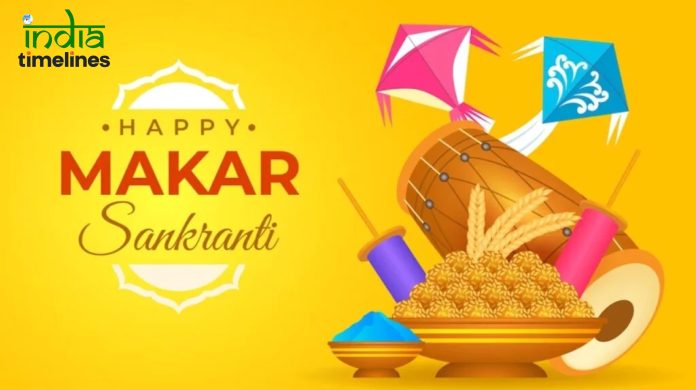
Makar Sankranti, a festival celebrated across India, holds immense cultural and historical significance. As we approach the year 2024, there is a prevalent question regarding the date and time of Makar Sankranti—whether it falls on January 14 or January 15. In this article, we will delve into the various aspects of Makar Sankranti, exploring its date, cultural importance, and the confusion surrounding its celebration.
Makara Sankranti 2024 – Time and Date
Usually, Makar Sankranti falls on January 14 every year. However, in leap years, Makar Sankranti falls on January 15. This year, the festival will be celebrated on January 15. According to Drik Panchang, the Punya Kala will start from 7:15 AM and will end at 17:46 PM. The Maha Punya Kala will start at 7:15AM and will end at 9AM on January 15.
Introduction to Makar Sankranti
Makar Sankranti marks the transition of the sun into the zodiac sign of Capricorn, symbolizing the end of the winter solstice. This auspicious day is celebrated with great fervor and joy across different regions of India.
Significance of Makar Sankranti
Historical Background
The roots of Makar Sankranti can be traced back to ancient times, with mentions in Hindu scriptures. Understanding the historical context adds depth to the appreciation of this festival.
Cultural Celebrations
Various regions celebrate Makar Sankranti with unique cultural rituals, showcasing the diversity that exists within the country. Understanding these cultural nuances enhances our appreciation of the festival.
Astronomical Perspective
Exploring the astronomical calculations behind Makar Sankranti helps us comprehend why the date may vary slightly each year.
Regional Variations
Different regions of India may observe Makar Sankranti on different dates due to regional variations and traditions.
January 14 or January 15: The Confusion
Factors Influencing the Date
Several factors contribute to the confusion around the specific date of Makar Sankranti. Exploring these factors can clarify the reasons behind the perceived ambiguity.
Impact on Celebrations
Understanding whether Makar Sankranti falls on January 14 or January 15 can significantly impact how communities plan and execute their celebratory events.
How People Celebrate Makar Sankranti
Traditional Customs
Delving into the traditional customs associated with Makar Sankranti provides insight into the richness of cultural practices during this festival.
Culinary Delights
Makar Sankranti is synonymous with various delectable dishes. Exploring the culinary aspect adds a flavorful dimension to our understanding of the festival.
Makar Sankranti: Beyond Borders
Global Observance
Examining how Makar Sankranti is celebrated beyond India’s borders highlights the festival’s global influence.
Influence on International Culture
Understanding how Makar Sankranti has permeated international culture showcases the festival’s significance on a global scale.
The Symbolism of Kites during Makar Sankranti
Historical Context
The tradition of flying kites during Makar Sankranti has a rich historical background that adds a colorful layer to the festival.
Modern Significance
Examining the modern-day symbolism of kites during Makar Sankranti reveals the festival’s adaptability to contemporary culture.
Makar Sankranti and Astrology
Zodiacal Alignment
Exploring the astrological aspect of Makar Sankranti sheds light on its alignment with the zodiac sign of Capricorn.
Spiritual Significance
Understanding the spiritual significance of Makar Sankranti deepens our appreciation for the festival’s holistic nature.
Regional Makar Sankranti Variations
Pongal in South India
Understanding how Pongal is celebrated in South India offers a glimpse into the regional variations of Makar Sankranti.
Magh Bihu in Assam
Exploring the unique traditions of Magh Bihu in Assam adds to the mosaic of Makar Sankranti celebrations across India.
Makar Sankranti: A Harvest Festival
Agricultural Practices
Examining the festival’s association with agriculture provides insights into its roots as a harvest festival.
Farmer’s Perspective
Understanding how farmers perceive Makar Sankranti offers a pragmatic view of its importance in agricultural communities.
Makar Sankranti and Climate Change
Observing Changes Over the Years
Examining the impact of climate change on Makar Sankranti showcases the festival’s adaptability in the face of environmental challenges.
Environmental Awareness
Understanding the environmental implications of Makar Sankranti celebrations prompts discussions on sustainability.
Common Misconceptions about Makar Sankranti
Astrological Misinterpretations
Addressing common misconceptions related to the astrological aspects of Makar Sankranti enhances our understanding of the festival.
Cultural Misunderstandings
Dispelling cultural misunderstandings around Makar Sankranti fosters a more inclusive celebration of the festival.
Makar Sankranti in the Digital Age
Social Media Impact
Examining the role of social media in shaping Makar Sankranti celebrations reflects the festival’s adaptation to the digital age.
Virtual Celebrations
The rise of virtual celebrations during Makar Sankranti underscores the festival’s ability to evolve with changing times.
Ensuring an Eco-Friendly Makar Sankranti
Sustainable Practices
Encouraging eco-friendly practices during Makar Sankranti promotes a harmonious celebration that respects the environment.
Impact on Nature
Understanding the ecological impact of traditional practices helps in making informed choices for a greener celebration.
Conclusion
In conclusion, Makar Sankranti is a festival that transcends time and borders, connecting people through its rich cultural tapestry. Whether it falls on January 14 or January 15, the essence of the celebration remains rooted in tradition, spirituality, and community. As we continue to celebrate Makar Sankranti, let us do so with a deeper understanding of its diverse facets and an unwavering commitment to preserving its essence for generations to come.
FAQs about Makar Sankranti 2024
1. Why does Makar Sankranti have different dates?
The varying dates are influenced by astronomical calculations and regional traditions.
2. What is the significance of flying kites during Makar Sankranti?
Flying kites symbolizes the transition of the sun and is a traditional way to celebrate the festival.
3. How do different regions in India celebrate Makar Sankranti differently?
Each region has unique customs and traditions, making the celebrations diverse and culturally rich.
4. Is Makar Sankranti only celebrated in India?
No, Makar Sankranti is observed globally, showcasing its influence on international cultures.
5. How can individuals contribute to an eco-friendly Makar Sankranti?
Adopting sustainable practices and being mindful of the environmental impact of celebrations can contribute to an eco-friendly Makar Sankranti.


































